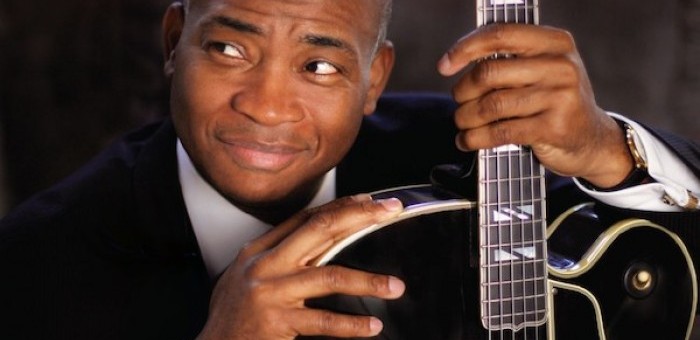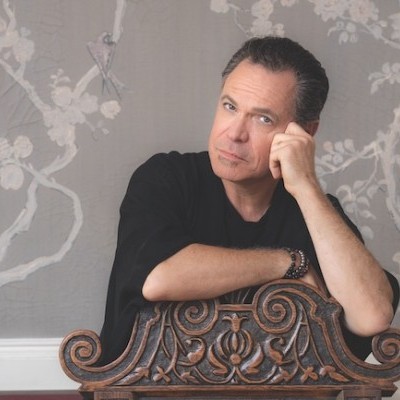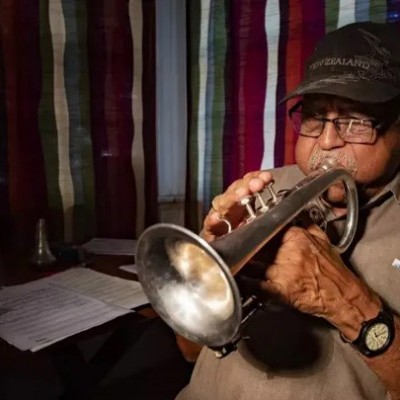Oct 28, 2025 10:47 AM
In Memoriam: Jack DeJohnette, 1942–2025
Jack DeJohnette, a bold and resourceful drummer and NEA Jazz Master who forged a unique vocabulary on the kit over his…

Guitarist Russell Malone’s new album is TIme For The Dancers (HighNote).
(Photo: Courtesy of the artist)It’s nearly impossible not to move while listening to Russell Malone’s enticing new album, Time For The Dancers (HighNote). The 53-year-old guitarist and composer packs plenty of boogie into his retooling of the Sir Roland Hanna-penned title track, provoking you to bob your head; the gutbucket “Leave It To Lonnie” invites you to get on the good foot; and the sensual reading of Peggy Lee’s “There’ll Be Another Spring” seduces you to sway slowly.
Complemented by the same ensemble featured on his 2016 disc, All About Melody (HighNote)—drummer Willie Jones III, pianist Rick Germanson, and bassist Luke Sellick—Malone delivers a bona fide “feel-good” album that will resonate with a wide audience.
DownBeat caught up with Malone to discuss the chemistry he’s forged with his current bandmates, which, with the substitution of Sellick for bassist Gerald Cannon, has recorded and toured with him for the past several years. Malone also discussed the inspirations behind some of the disc’s tunes.
Let’s talk about the chemistry you’ve forged with this band. Even with Sellick being relatively new to the ensemble, the rapport is quite strong. And a lot of these songs were road-tested before you recorded them.
A lot of it has to do with trust. When you have trust, you don’t have to try to make something happen. Everything will take care of itself. That applies to relationships in general—not just in music.
The title of the album is Time For The Dancers. Talk a bit how the concept of dance—regardless of what kind—helps you shape your melodies and improvisations.
Remember the first time you heard music—probably as a little child? The first time I heard music was in church. I wasn’t concerned about the technical aspects of the music. The first time I heard music, it made me want to dance. That’s what music is supposed to do.
There’s definitely that element of wanting to listen, to take things apart and analyze them. That’s all good, too. But I think if someone wants to dance to the music, it’s natural.
I had conversations with some of the older jazz players, like Lou Donaldson and Benny Golson—and they talked about how years ago people would dance to the music. When the beboppers got a hold of it, the music became more of this intellectual thing, where you just sat down and listened to it. And that’s all well and good, too. But I like people to dance to my music and have a good time.
I know some musicians who don’t like that; they [get] distracted by people clapping and dancing during the performance. I’ve been onstage with some musicians who really get uptight when the audience gets very vocal and physical with enthusiasm. Usually, it was someone who was younger and took themselves a little too seriously. They take offense to people responding that way.
But people dancing and responding vocally never bothered me. I think it has something to do with my musical upbringing. I played all kinds of gigs—country, funk, jazz and gospel.
Could you reflect on your experience with bassist Lonnie Plaxico? When I first heard the tune “Leave It To Lonnie,” I thought it was a reference to Dr. Lonnie Smith because of the groove.
Lonnie [Plaxico] and I met when I first came to New York back in 1985. We worked at Barry Harris’ Jazz Cultural Theater. They had jam sessions at this place. Lonnie’s only a couple of years older than me. But he was already on the scene, playing with Dizzy Gillespie, Art Blakey and Dexter Gordon. Lonnie and I ended up playing together onstage at the jam session. After we finished playing, Lonnie walks up to me and says, “Hey man, you sound good,” then asked me where I was from. I told him Atlanta. Then he said, “You sounded great. You got a good feeling and you hear changes really well. But while you may get away with playing that way down in Georgia, you can’t get away with that kind of playing up here in New York.”
His comment caught me off guard. He said, “I can hear a lot of your influences. But at some point, you’re going to have to play who you are, because New York has already seen the Grant Greens, the Wes Montgomerys, the Kenny Burrells and the George Bensons. And the reason why they were able to thrive when they came here was because they had something of their own to offer.”
Nobody had ever told it to me like that. I got to thinking about some of my experiences on the local scene in Georgia. Not only did people there expect you to sound a certain way; they expected you to sound like other people down there.
Lonnie gave me some of the best advice ever. We have remained friends ever since.
Many different kinds of artists receive the type of advice that Lonnie gave you. But hearing that advice is far easier than actually applying it. Talk about the point in which first you recognized in your music that you were playing who you are.
Everybody has a voice. You can take the most derivative-sounding musician and if you listen to them [long] enough, you’re going to hear some things that are unique. What that type of musician doesn’t always have—particularly when they’re young —is the confidence to speak in their personal voice.
Early on in everyone’s development, you want to be accepted and liked. When I was a younger musician, there were certain things that I felt I had to play or needed to play just so people would accept me. I understood what Lonnie told me, but sometimes it takes time for certain things to really sink in.
I got to a certain age where I said to myself, “As much as I love all of the people who’ve influenced me, when it comes to being Russell Malone, there’s nobody better. There’s nobody better than me at me being me.” That was a revelation for me. I learned to embrace my so-called imperfections, my quirks, even my ethnicity.
I don’t care if West Montgomery came back down to Earth with wings on his back, playing a golden guitar with golden strings; I still have to play me.
Another revelation that came to me when I got older is that I didn’t have to like everything about my mentors; I don’t have to make the same musical choices. It’s like realizing that your parents aren’t perfect. As much you love, respect and appreciate them, you realize that they are not infallible.
On Time For The Dancers, you revisit some of your older songs, such as “A Ballad For Hank Crawford.” In the liner notes, you mention that it took you almost a decade to complete that tune. Why so long?
I had never recorded that tune before. I actually began working on it when I first started making records. I’d thought about putting it on my Black Butterfly record [in 1993], but the tune wasn’t quite ready yet. And at that time, I wasn’t even thinking about Hank Crawford; I just had this soulful, bluesy idea in my head.
Then I got to hanging out with Hank Crawford. We worked together on this B.B. King record, Let The Good Times Roll [1999]; it was a tribute to Louis Jordan. I heard Hank’s music on the radio a lot; I just loved the way he played.
After that session, I started messing around with that tune again. I came up with some different things that I wanted to incorporate, then I left it alone. A couple of years later, I went back and finished it. I think it really captures Hank.
You also revisit “Flowers For Emmett Till.” That song was on your 1992 debut as well as 2004’s Bluebird with pianist Benny Green. Why did you feel the need to revisit it at this particular time?
A lot of people liked that song. The thing that inspired it was me being in junior high school and having one of my teachers who was always trying to keep us socially conscious and culturally aware about our history. One day, she came to school with a Jet magazine that had an article about the death of Emmett Till [1941–’55]. She told the story about how he was accused of getting fresh with a white woman. She showed us the picture of his mutilated body in the coffin, and then said, “This is what hate and ignorance look like.”
I had nightmares about that picture for a long time. I never told my parents about those nightmares. So I started hearing this melody in my head when I was still that little kid even though I had a lot to learn musically. But I could play that little melody on the guitar—just those single notes. As I started advancing as a [musician], I decided to play it on my first record on nylon-string guitar in a pseudo-classical way. Then on the record with Benny Green, I played it solo again but on electric guitar.
When I was putting the music together for this latest recording, I wanted to play it because I was never completely satisfied with the previous versions. So I decided to try it with an ensemble. And it turned out pretty well.
Plus, the lady [Carolyn Bryant] who accused Emmett of making a pass [in a Mississippi grocery store in 1955] came out this year to confess that she lied. When I heard that, I said, “Well, I’ll be damned! A [teenager’s] life was taken violently because of ignorance, hate and lies.”
So much stuff has happened, and we still have a long way to go. … I have fans from all over the place, of all different nationalities and colors. So things like this need to be talked about. DB

Jack DeJohnette boasted a musical resume that was as long as it was fearsome.
Oct 28, 2025 10:47 AM
Jack DeJohnette, a bold and resourceful drummer and NEA Jazz Master who forged a unique vocabulary on the kit over his…

“Think of all the creative people I’m going to meet and a whole other way of thinking about music and a challenge of singing completely different material than I would have sung otherwise to my highest level in dedication to the moment,” Elling says about his Broadway run.
Sep 9, 2025 1:18 PM
Kurt Elling was back at home in Chicago, grabbing some family time in a late-June window between gigs. Sporting a smile…

Pat Metheny will perform with his Side-Eye III ensemble at Big Ears 2026 in Knoxville, Tennessee, next March.
Sep 9, 2025 12:19 PM
Big Ears has announced the lineup for its 2026 festival, which will take place March 26–29 and include 250…

“[That’s] the thing of the beboppers,” Bradford said. “These guys were important for not only playing that wonderful music, but they knew a sort of social stance, you see?”
Sep 9, 2025 1:07 PM
It was a calm, balmy, near-perfect evening in Westwood, California, not far from UCLA, in the expansive courtyard at…

Esperanza Spalding closed an audacious Chicago Jazz Festival set with “Endangered Species.”
Sep 9, 2025 11:50 AM
The 45th Chicago Jazz Festival kicked off its headline events with two erudite individuals, Esperanza Spalding and…